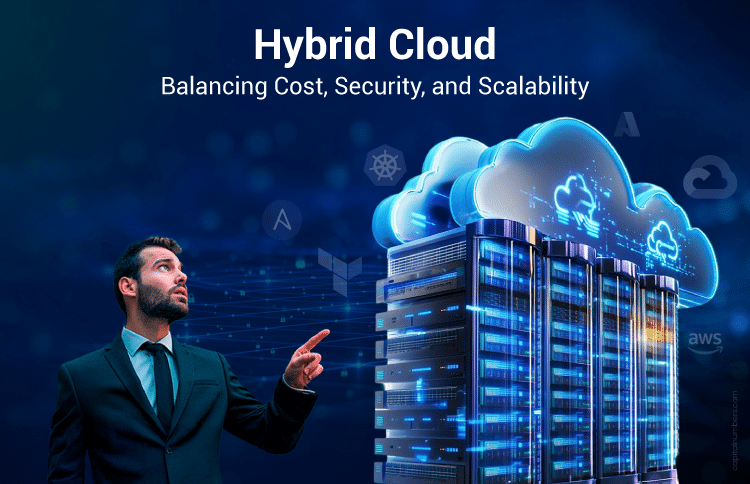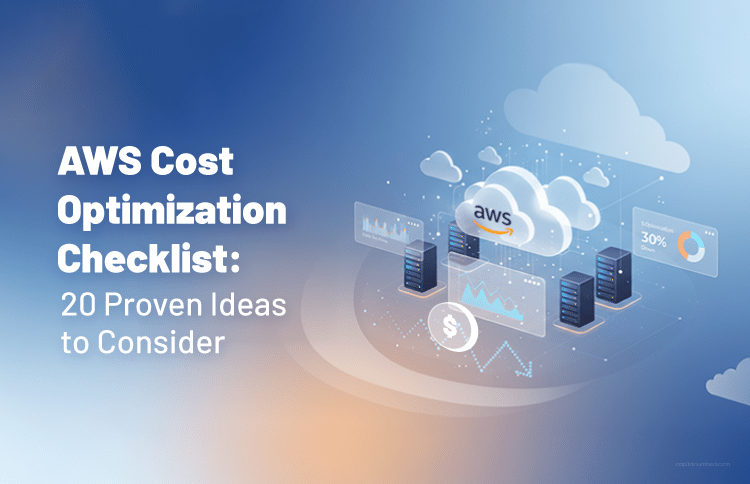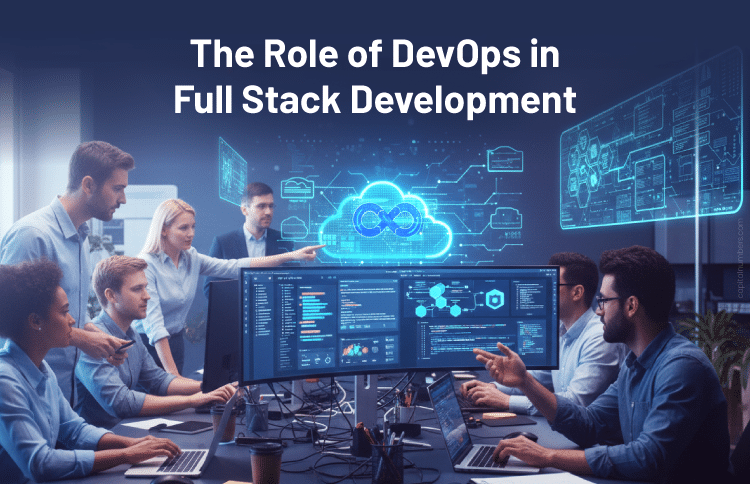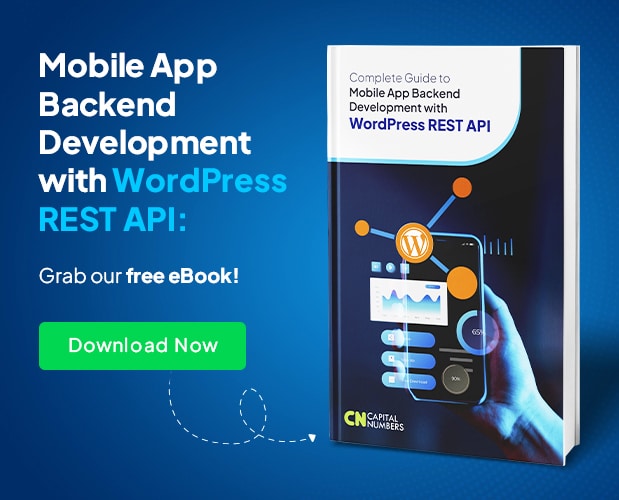Hybrid Cloud: Balancing Cost, Security, and Scalability
Table of Contents
Your business is caught between two worlds. On one hand, a private data center offers control, but it is slow and expensive to scale. On the other hand, the public cloud is fast and flexible, but it can lead to unpredictable costs and security concerns. This constant trade-off between public and private cloud slows innovation, strains budgets, and limits growth.
Hybrid cloud ends that struggle. It combines the reliability and control of private infrastructure with the speed and scalability of the public cloud – without forcing you to compromise. The result? Lower costs, stronger security, and the freedom to scale when you need it.
In this blog, we’ll explore how the hybrid cloud strategy enables businesses to balance cost, security, and scalability, and why it could be the smartest choice for your company’s future. So, what to wait for? Read on.
Understanding the Hybrid Cloud
Before you can master the hybrid cloud strategy, you need to understand the platform. Let’s demystify what a hybrid cloud is and how it differs from other cloud models.
A hybrid cloud is more than just a combination of different environments; it is a unified, interoperable system. It represents a computing architecture that integrates at least one public cloud and one private cloud, with on-premises infrastructure often serving as the foundational layer. This model works effectively by allowing easy movement of data and workloads, all managed through a single platform and supported by a reliable CI/CD pipeline.
Public Cloud:
Think of a public cloud as a shared, multi-tenant utility. Providers like AWS, Azure, or Google Cloud offer a vast pool of compute, storage, and networking resources on a pay-as-you-go basis. The key benefits include immense scalability, a global footprint, and a rich ecosystem of managed services across the technology stack – from IaaS to PaaS and SaaS offerings. However, because it’s multi-tenant, control is given to the provider, which can create challenges for handling sensitive data.
Private Cloud:
This is a cloud computing environment dedicated exclusively to a single organization. It can be physically located within your data center (on-premises) or hosted by a third-party provider on a private network. The key feature is the complete control it offers over hardware, software, and data. This control is crucial for meeting strict regulations and ensuring reliable performance for important applications.
On-Premises Infrastructure:
This is your traditional, physical data center. While not a “cloud” in the modern sense, it remains a critical component of many hybrid architectures. Legacy enterprise applications, sensitive databases, and systems with low-latency requirements often reside here. The hybrid model lets you extend the life of valuable assets instead of going through a costly and disruptive “rip-and-replace” migration.
Orchestration Tools:
These tools are the backbone of a hybrid cloud. Tools like Kubernetes, Red Hat Ansible, Terraform, and vendor-specific platforms (AWS Outposts, Azure Stack HCI, Google Anthos) help automate the deployment, management, and scaling of your applications across different environments. They offer a single interface to manage your resources, ensuring consistency and a smooth workflow whether your workloads are on-premises or in the cloud.
The key differentiator for a hybrid cloud is the interoperability and orchestration between these environments. This is where it differs from a multi-cloud strategy, which involves using multiple public cloud providers without a dedicated, integrated private component. While a hybrid cloud can also be a multi-cloud (e.g., using AWS and Azure in conjunction with a private cloud), its defining feature is the bidirectional communication between public and private domains.
Is Your IT Infrastructure Ready for Hybrid Cloud Transformation?
At Capital Numbers, we offer advanced cloud engineering services designed to optimize your hybrid cloud strategy. Whether you’re looking to seamlessly integrate public and private cloud environments or scale your resources dynamically, our team ensures that your infrastructure is secure, cost-efficient, and ready to meet the demands of tomorrow.
Contact us today for cloud engineering services!
Hybrid Cloud vs. Other Cloud Models
Eager to know how hybrid cloud differs from other ones? Here are the key differences between hybrid cloud and other cloud models at a glance:
| Feature | Hybrid Cloud | Multi-Cloud | Private Cloud |
|---|---|---|---|
| Components | Public cloud and private cloud/on-premise systems. | Multiple public clouds from different providers. | A single, dedicated cloud environment. |
| Integration | Seamlessly integrates and orchestrates workloads across environments. | Workloads may or may not be integrated, often running in silos. | Self-contained within a single environment. |
| Primary Goal | To balance security and control with scalability and flexibility. | To avoid vendor lock-in and use the best services from different providers. | To provide a high degree of control, security, and compliance. |
| Example Use Case | Running a sensitive database on-premise while a customer-facing app “bursts” to the public cloud during peak traffic. | Using AWS for data analytics and Azure for development, with no direct connection between them. | A financial institution hosts all its applications and data in its dedicated data center. |
| Can it be both? | Yes, a hybrid cloud can also be a multi-cloud if it uses more than one public cloud provider in addition to a private cloud. | Yes, a multi-cloud can also be a hybrid cloud if it includes a private cloud component. | No, a private cloud is a single environment and does not involve a public cloud by itself. |
The Business Challenge: Cost, Security, and Scalability
In today’s digital world, businesses need to solve a complex trilemma, where balancing cost, security, and scalability is crucial.
Cost Pressures
The shift to cloud computing, while beneficial, has introduced new financial complexities.
- Rising cloud bills and unpredictable pricing models: The pay-as-you-go model of public clouds can lead to surprising and often-escalating monthly bills, especially for organizations that lack proper governance and cost-monitoring tools. Without robust FinOps practices and a dedicated cloud cost optimization strategy, your unchecked resource usage can quickly waste expected savings.
- CapEx vs OpEx considerations: The traditional IT model involved significant capital expenditure (CapEx) for hardware. Cloud computing shifts this to operational expenditure (OpEx). This can make long-term financial forecasting difficult and lead to a feeling of “renting” infrastructure indefinitely.
- Cost of maintaining legacy infrastructure: Many organizations struggle with the cost and effort of maintaining old on-premise systems. It can limit their ability to invest in new, more efficient technologies.
Security Concerns
Your business success depends on trust. But in a world of increasing cyber threats and strict regulations, security is a top priority.
- Data sovereignty and compliance (GDPR, HIPAA, etc.): Legal and industry regulations often dictate where sensitive data can be stored and how it must be handled. This makes a public-cloud-only approach impossible for many businesses in regulated industries.
- Risks of public cloud exposure: Storing critical or confidential data in a shared public environment, even with the provider’s robust security measures, can create a psychological and real-world risk of exposure and data breaches.
- Internal vs external threat mitigation: Businesses must protect their data from external attacks and potential internal threats. A hybrid model allows for greater control over who has access to sensitive data within the organization’s private environment.
Scalability Demands
Traditional on-premises infrastructure often fails when it comes to scaling with market demands.
- Seasonal spikes, global expansion, and digital transformation: Business growth, marketing campaigns, or holiday seasons can cause sudden, massive surges in demand. On-premise infrastructure cannot handle these without significant and costly over-provisioning.
- Limitations of private infrastructure: The physical nature of a private data center means that scaling up capacity is a slow, manual, and expensive process that cannot meet the need for on-demand elasticity.
- Need for elastic resources without overprovisioning: To remain competitive, you should scale resources up or down to meet demand instantly. You should pay only for what you use, without having to purchase and maintain excess hardware.
How Hybrid Cloud Addresses These Challenges?
A well-architected hybrid cloud model is not just a solution; it’s a strategic framework for solving the trilemma.
a. Cloud Cost Optimization:
A hybrid cloud allows for what’s known as intelligent workload placement. You can analyze your applications and data to determine the most cost-effective and performant location for them, moving beyond a one-size-fits-all approach.
- Workload Triage: You can categorize workloads based on their resource needs and sensitivity to optimize the cloud cost. For instance, stable, predictable applications with a fixed resource footprint (e.g., legacy ERP systems or core banking platforms) are ideal candidates for the private cloud. This uses your existing CapEx investment and provides consistent performance without incurring variable OpEx costs.
- Cloud Bursting: This is the typical hybrid cloud use case. When an application experiences a sudden and temporary surge in demand, such as an e-commerce platform during Black Friday or a streaming service during a live event, the system automatically provisions additional resources from the public cloud. This “burst” of compute power is managed seamlessly, and the resources are removed when demand subsides, so you only pay for what you use. This flexibility is a key benefit of hybrid cloud.
- Reduced Infrastructure Overhead: This is another key strategy for optimizing cloud costs. By shifting busy or development tasks to the public cloud, your on-site hardware can work more efficiently, reducing upgrade costs.
b. Enhanced Security:
The hybrid cloud model provides a powerful architecture for safeguarding sensitive data while still using public cloud benefits. The following are the ways to enhance security with a hybrid cloud:
- Data Sovereignty: The private cloud or on-premises component serves as the safe zone for sensitive data. Workloads involving Personally Identifiable Information (PII), Protected Health Information (PHI), or financial records can be executed in this controlled environment, ensuring compliance with regulations like GDPR and HIPAA. This provides a clear separation of concerns, with highly sensitive data residing in a secure, audited domain.
- Controlled Access and Micro-segmentation: You can use a private network connection, like an AWS Direct Connect or Azure ExpressRoute, to create a secure, high-bandwidth link between your private cloud and the public cloud. This allows for controlled access and granular micro-segmentation of your network. It limits the attack surface and ensures that only authorized traffic can traverse the hybrid environment.
- Integration with Existing Security Protocols: A hybrid cloud strategy enables you to extend your existing Identity and Access Management (IAM) and security protocols to the public cloud, creating a unified security posture. This eliminates the need to duplicate security tools and processes, ensuring consistency and simplifying compliance.
c. Scalable Infrastructure:
The hybrid cloud model transforms your infrastructure from a static, rigid asset into a dynamic, flexible resource. Here is how you can ensure scalability in cloud computing:
- Dynamic Resource Allocation: By using Kubernetes and other container orchestration platforms, you can automate the deployment and scaling of applications across both your private and public clouds. This allows for portability, where you can deploy a containerized application on-premises and burst it to the public cloud with minimal configuration changes. The adoption of microservices architectures, which break down monolithic applications into smaller, independent services, further enhances this flexibility. Serverless computing can also be used for event-driven functions, allowing you to pay for code execution only when needed, which is ideal for sporadic, unpredictable tasks.
- Disaster Recovery (DR) and Business Continuity: Instead of maintaining a costly, idle secondary data center, you can use the public cloud as an on-demand disaster recovery site. In the event of a primary site failure, you can fail over mission-critical workloads to the public cloud, ensuring business continuity with a significantly lower Total Cost of Ownership (TCO).
- Supporting Innovation: For development and testing environments, the hybrid cloud is a perfect fit. Developers can rapidly spin up isolated environments in the public cloud, use a Platform as a Service (PaaS) database, and run automated tests without waiting for hardware provisioning. This accelerates the DevOps lifecycle and ensures a culture of rapid innovation.
Optimized E-commerce Performance and Traffic with Google Cloud
A leading e-commerce brand was facing challenges with scaling, manual operations, security, and cost overruns.
Learn how our team uses Google Cloud Platform (GCP) to ensure effortless scalability, zero downtime, cost savings, and more. [Read the case study here!]
Real-World Use Cases of Hybrid Cloud
The power of hybrid cloud is evident across a wide range of industries, including the following ones: .
Financial Services:
Banks use a hybrid model to run core banking systems and sensitive transaction processing in a private cloud to ensure regulatory compliance. They then use the public cloud for customer-facing mobile apps, algorithmic trading platforms, and big data analytics that require massive, on-demand compute power.
Healthcare:
Hospitals keep EHRs (Electronic Health Records) and other PHI (Protected Health Information) in a private cloud for security and compliance with HIPAA. They use the public cloud to power telehealth services, patient portals, and scalable research applications.
Retail:
Retailers use the public cloud for their e-commerce storefronts to handle seasonal traffic spikes. Inventory management and point-of-sale systems, which require low latency and high availability, are often kept on-premises or in a private cloud.
Manufacturing:
With the rise of the Industrial Internet of Things (IIoT), manufacturers are using a hybrid approach to process time-sensitive sensor data at the “edge” in a private cloud or on-premises. Long-term data storage and large-scale predictive analytics are then offloaded to the public cloud, where storage is more cost-effective.
Common Pitfalls to Avoid in Hybrid Cloud
A hybrid cloud is a powerful strategy, but only if you avoid the common mistakes that can derail your progress. This section will help you sidestep the most frequent challenges and build a foundation for long-term success.
Underestimating Integration Complexity
Integrating different environments can be tricky. Without a clear grasp of networking, security, and data syncing, you might run into issues like delays, data inconsistencies, and poor app performance.
Poor Governance and Access Control
A lack of a unified governance model can lead to shadow IT and security vulnerabilities. Implementing a single management plane and a consistent IAM policy across all environments is critical.
Lack of Visibility Across Environments
Managing two or more distinct environments requires a unified view. A lack of visibility into resource utilization, costs, and performance across your entire hybrid landscape can lead to inefficiencies and operational silos.
Vendor Lock-in and Interoperability Issues
Be mindful of proprietary tools and services that could lock you into a single provider. Opt for open standards and technologies that allow for greater interoperability and flexibility in the future.
Implementing Hybrid Cloud: A Step-by-step Approach
You understand the “what” and the “why,” and you’re aware of the potential pitfalls. Now, let’s look at the “how.” Implementing a hybrid cloud is not a one-size-fits-all solution. A successful transition requires careful planning and a strategic roadmap. Here it is:
Step 1: The Assessment Phase
- Goal: Understand your current IT landscape and define your future goals.
- Action: Inventory all your existing applications and data. For each one, ask: Does this need to stay on-premises for security or compliance? Can it run more efficiently in the public cloud? This “workload assessment” is the most important step.
Step 2: The Foundation Phase
- Goal: Build a secure and connected bridge between your private and public clouds.
- Action: Set up the network connection that will link your environments. Implement a unified security and governance framework, and choose the right management tools to give you that “single pane of glass” view we discussed earlier.
Step 3: The Pilot Phase
- Goal: Test your new hybrid environment with a low-risk project.
- Action: Select a simple, non-critical application or workload to move to the public cloud. This is your chance to build your team’s skills, refine your processes, and prove the concept before you tackle more complex tasks.
Step 4: The Migration Phase
- Goal: Move your workloads in a structured, phased manner.
- Action: Based on your initial assessment, begin migrating workloads in a logical order. Start with the easiest applications and move toward more complex ones. Focus on moving a few at a time to minimize disruption and risk, and ensure a seamless cloud migration.
Step 5: The Optimization Phase
- Goal: Continuously improve performance and manage costs.
- Action: Once your hybrid environment is up and running, your work isn’t done. Actively monitor performance, optimize resource allocation, and use automation to scale resources up or down automatically. This ongoing optimization is key to long-term success.
How to Measure ROI Beyond Cost Savings in Hybrid Cloud?
When we talk about hybrid cloud ROI, we often focus on the financial bottom line. But the true value of a hybrid cloud strategy is far greater than just saved money; it’s about a more agile, secure, and innovative business. This section shows you how to measure the real, strategic benefits of hybrid cloud.
Increased Agility and Speed
With hybrid cloud, you can quickly deploy new applications and services. It helps you adapt to market changes and customer demands faster, giving you a competitive edge.
Better Security and Compliance
By keeping sensitive data on private cloud or on-premises systems, you can meet regulatory requirements while still using the scalability and innovation of public clouds. It reduces risks and ensures compliance.
Operational Efficiency
Hybrid cloud allows you to optimize resource use, running predictable workloads on private infrastructure and scaling with public cloud resources during peak demand. It improves performance and reduces overhead.
Improved Disaster Recovery
Hybrid cloud ensures better business continuity by storing your data across multiple environments. With this, you can minimize downtime and recover quickly during system failures.
You May Also Read: Cloud Computing in 2025: What’s Next for the Industry?
Bottom Line
It is no longer a war of public vs private cloud. The future of IT infrastructure lies in a hybrid approach that combines the strengths of both. By moving predictable workloads to a private cloud and using the public cloud for dynamic needs, you gain control, agility, and cost efficiency.
Hybrid cloud enables innovation, business continuity, and enhanced security, creating a resilient, scalable foundation for the future. It’s time to see your IT infrastructure as a strategic partnership, not a binary choice.


















